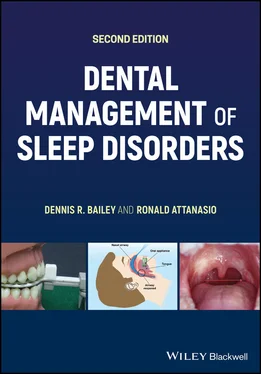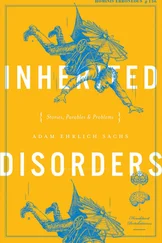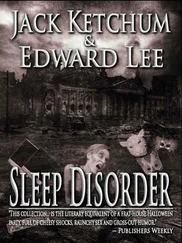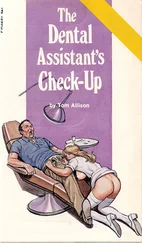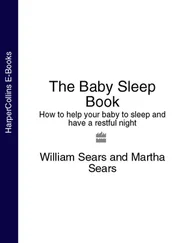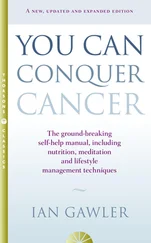Ronald Attanasio - Dental Management of Sleep Disorders
Здесь есть возможность читать онлайн «Ronald Attanasio - Dental Management of Sleep Disorders» — ознакомительный отрывок электронной книги совершенно бесплатно, а после прочтения отрывка купить полную версию. В некоторых случаях можно слушать аудио, скачать через торрент в формате fb2 и присутствует краткое содержание. Жанр: unrecognised, на английском языке. Описание произведения, (предисловие) а так же отзывы посетителей доступны на портале библиотеки ЛибКат.
- Название:Dental Management of Sleep Disorders
- Автор:
- Жанр:
- Год:неизвестен
- ISBN:нет данных
- Рейтинг книги:3 / 5. Голосов: 1
-
Избранное:Добавить в избранное
- Отзывы:
-
Ваша оценка:
- 60
- 1
- 2
- 3
- 4
- 5
Dental Management of Sleep Disorders: краткое содержание, описание и аннотация
Предлагаем к чтению аннотацию, описание, краткое содержание или предисловие (зависит от того, что написал сам автор книги «Dental Management of Sleep Disorders»). Если вы не нашли необходимую информацию о книге — напишите в комментариях, мы постараемся отыскать её.
Dental Management of Sleep Disorders
Dental Management of Sleep Disorders, Second Edition
Dental Management of Sleep Disorders — читать онлайн ознакомительный отрывок
Ниже представлен текст книги, разбитый по страницам. Система сохранения места последней прочитанной страницы, позволяет с удобством читать онлайн бесплатно книгу «Dental Management of Sleep Disorders», без необходимости каждый раз заново искать на чём Вы остановились. Поставьте закладку, и сможете в любой момент перейти на страницу, на которой закончили чтение.
Интервал:
Закладка:
Obstructive sleep apnea disordersICD‐10‐CM code: G47.33Applies to both adult and pediatric
Central sleep apnea syndromes
The dentist is not likely to encounter central sleep apnea. The one to consider might possibly be central sleep apnea due to a medication or substance. This may be associated with the use of opioids, or when using some other respiratory depressant medication.
Sleep‐related hypoventilation disorders
Sleep‐related hypoxemia disorder ICD‐10‐CM code: G47.36
The dentist is not likely to encounter this specifically. If the patient's blood oxygen is equal to or less than 88% for greater than five minutes, then this may be present and should be further evaluated by a physician as hypoxia has implications that are outside the scope of the dentist.
Isolated symptoms and normal variants
The most commonly encountered condition here is snoring. Despite the fact that an ICD code exists for snoring (R06.83), this is typically not a billable or reimbursable service. The presence of snoring indicates the potential risk for sleep apnea and if present should be evaluated further.
Central Disorders of Hypersomnolence
In this category there are a number of disorders that patients may be at risk for that the dentist may recognize.
Narcolepsy Type 1ICD‐10‐CM code: G47.411
Narcolepsy may have many of the same symptoms as sleep apnea, especially daytime sleepiness. Oftentimes it is difficult to make a distinction and if suspected it is advisable to refer the patient to a sleep medicine specialist. This form of narcolepsy has also been referred to narcolepsy with cataplexy, a sudden loss of muscle weakness associated with emotions.
Narcolepsy Type 2 ICD‐10‐CM code: G47.419
This type of narcolepsy is also referred to as Narcolepsy without cataplexy. The symptoms are similar to type 1 narcolepsy.
Idiopathic hypersomnia ICD‐10‐CM code: G47.11
The symptoms here may be similar to SRBD as it relates to daytime sleepiness. Further investigation of this should be done.
It has been proposed that this condition may actually represent another form of narcolepsy that is being termed narcolepsy Type 3 [7]. This has the potential to better define the disorder, improve reimbursement, and most importantly enhance the pharmacologic management.
Hypersomnia due to a medical disorderICD‐10‐CM code: G47.14
This may be present because of an underlying medical or neurologic disorder. A more in‐depth history needs to be obtained to determine if it may be related to a medical condition.
Hypersomnia due to medication or substance
This may be due to medications that have the potential for sedation, when there is the potential for substance abuse or when the patient is withdrawing from the use of stimulants. Abuse of alcohol should be a concern. This condition is also of concern when prescribing medications that may be sedating.
Hypersomnia associated with a psychiatric disorder
This applies to anyone who has been diagnosed with depression or may be at risk for depression and may be suspect for having excessive sleepiness as a symptom.
Circadian Rhythm Sleep–Wake Disorders
These disorders are ones that the dentist will not typically encounter. Having an understanding of these and being able to explain their presence and significance to the patient may prove helpful in some circumstances.
Delayed sleep–wake phase disorder
This is a disorder associated with the delay of sleep onset by at least two hours relative to what is considered socially acceptable. There is typically a delay in the wake up time as well. Oftentimes this is found in the adolescent population and possibly in some young adults.
Advanced sleep–wake phase disorder
In this situation, the onset of sleep is typically two or more hours earlier than what might be considered acceptable. This is more typically seen in older people and may be more prevalent in people who are retired or do not have a daily routine.
Shift work disorder
This may impact many aspects of life such as reported sleep time, sleep quality, reduced work performance, safety issues, drowsy driving at the end of a shift, mood swings, and even health‐related consequences.
Jet lag disorder
This causes a disruption in the sleep–wake schedule and is typically worse when more time zones are involved. Typically this is worse when traveling east as opposed to the west. This can be impacted by alcohol and caffeine. The typical estimate is that it takes one day per time zone to adjust to the new local time.
Parasomnias
This group of disorders is further broken down into four groups: non‐rapid eye movement (NREM)‐related parasomnias, REM‐related parasomnias, other parasomnias, and isolated symptoms and normal variants. The ones that are more commonly encountered by the dentist are listed here.
NREM‐related parasomnias:
Sleepwalking (also known as somnambulism)
Sleep terrors
These are associated with arousals from N3 sleep, usually in the first part of the night, and may be associated with a scream. It is considered a disorder of arousals, which is usually of short duration and if awakened the person may seem confused. Typically it is found more in children and usually resolves during puberty.
Sleep‐related eating disorder
This can be associated with a partial arousal, typically from N2 or N3 sleep, so there may be limited recall. The disorder occurs during any period of sleep and the focus may be on high calorie foods. There can be an association with dreaming and potentially with the use of a sedative‐hypnotic medication. It is unusual to consume alcohol or any type of liquid. This occurs more in females. If the person is confronted or interfered with, they may become irritated or agitated.
Confusional arousals
These typically occur while in bed and resolve once out of bed.
REM‐Related Parasomnias
REM sleep behavior disorder (RBD)
This is typically associated with what is known as dream enactment. Help is often requested after an injury has occurred. There are reports that this may be related to narcolepsy, to PLMs, and in some instances to medications especially antidepressants serotonin specific reuptake inhibitor (SSRIs). When a sleep study is conducted atonia may be absent for longer periods. The presence of this has been shown to be a sign that the risk of a neurodegenerative disorder (dementia, Alzheimer’s, or Parkinson’s) is present. RBD may be present as much as a decade before and is more common in men over 50.
Nightmare disorder
These occur during the second half of the night and are related to REM sleep and to vivid dreams. They are more frequent in children, are associated with an awakening, and often the individual can provide a good description of the event.
Other Parasomnias
Sleep enuresis
This is typically more prevalent in children and may be associated with another sleep disorder especially the SRBD. There may also be an associated medical condition.
Parasomnias due to a medical disorder
This is typically associated with a medical or neurologic disorder and RBD is the most common.
Parasomnias due to a medication or substance
When any of the parasomnias are present, investigation of medication use and alcohol use should be investigated.
Isolated symptoms and normal variants – sleep talking
Sleep talking can be associated with either REM or NREM sleep. It can be disruptive to the bed partner or others in the room. This may be associated with RBD.
Sleep‐Related Movement Disorders
In this category, a number of these are commonly known but may not be fully understood. For sake of clarity, not all of them will be listed here, only the ones that the dentist may be more likely to encounter. The ones of greatest interest to the dentist are:
Читать дальшеИнтервал:
Закладка:
Похожие книги на «Dental Management of Sleep Disorders»
Представляем Вашему вниманию похожие книги на «Dental Management of Sleep Disorders» списком для выбора. Мы отобрали схожую по названию и смыслу литературу в надежде предоставить читателям больше вариантов отыскать новые, интересные, ещё непрочитанные произведения.
Обсуждение, отзывы о книге «Dental Management of Sleep Disorders» и просто собственные мнения читателей. Оставьте ваши комментарии, напишите, что Вы думаете о произведении, его смысле или главных героях. Укажите что конкретно понравилось, а что нет, и почему Вы так считаете.
